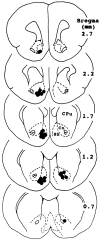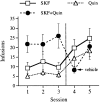Role of dopamine D1 and D2 receptors in the nucleus accumbens in mediating reward
- PMID: 9334429
- PMCID: PMC6573749
- DOI: 10.1523/JNEUROSCI.17-21-08580.1997
Role of dopamine D1 and D2 receptors in the nucleus accumbens in mediating reward
Abstract
The objectives of this study were to examine the involvement of D1 and D2 receptors within the nucleus accumbens (ACB) in mediating reinforcement. The intracranial self-administration (ICSA) of D1 and D2 agonists was used to determine whether activating D1 and/or D2 receptors within the ACB of Wistar rats is reinforcing. At concentrations of 0.25, 0.50, and 1.0 mM (25, 50, and 100 pmol/100 nl of infusion), neither the D1 agonist R(+)-1-phenyl-2,3,4,5-tetrahydro-1H-3-benzazepine-7,8-diol [SKF 38393 (SKF)] hydrochloride nor the D2 agonist (-)-quinpirole (Quin) hydrochloride was self-administered into the shell region of the ACB. On the other hand, equimolar mixtures of SKF and Quin (SKF+Quin), at concentrations of 0.25, 0.50, and 1.0 mM each, were significantly self-infused into the ACB shell. The core region of the ACB did not support the ICSA of SKF+Quin at any of these concentrations. Rats increased lever pressing when the response requirement was increased from a fixed ratio 1 (FR1) to FR3, and they responded significantly more on the infusion lever than they did on the control lever. Coadministration of either 0.50 mM R(+)-7-chloro-8-hydroxy-3-methyl-1-phenyl-2,3,4, 5-tetrahydro-1H-3-benzazepine (SCH 23390) hydrochloride, a D1 antagonist, or 0.50 mM S(-)-sulpiride, a D2 antagonist, completely abolished the ICSA of the mixture of SKF+Quin (each at 0.50 mM) into the ACB shell. The present results suggest that concurrent activation of D1- and D2-type receptors in the shell of the ACB had a cooperative effect on DA-mediated reward processes.
Figures







Similar articles
-
Contralateral turning elicited by unilateral stimulation of dopamine D2 and D1 receptors in the nucleus accumbens of rats is due to stimulation of these receptors in the shell, but not the core, of this nucleus.Psychopharmacology (Berl). 1996 Aug;126(3):185-90. doi: 10.1007/BF02246447. Psychopharmacology (Berl). 1996. PMID: 8876017
-
Cooperative activation of D1-like and D2-like dopamine receptors in the nucleus accumbens shell is required for the reinstatement of cocaine-seeking behavior in the rat.Neuroscience. 2006 Oct 13;142(2):451-61. doi: 10.1016/j.neuroscience.2006.06.004. Epub 2006 Jul 14. Neuroscience. 2006. PMID: 16844308
-
Role of dopamine D1 and D2 receptors in the nucleus accumbens in jaw movements of rats: a critical role of the shell.Eur J Pharmacol. 1995 Nov 3;286(1):41-7. doi: 10.1016/0014-2999(95)00428-n. Eur J Pharmacol. 1995. PMID: 8566150
-
Dopamine D1 receptor signaling: does GαQ-phospholipase C actually play a role?J Pharmacol Exp Ther. 2014 Oct;351(1):9-17. doi: 10.1124/jpet.114.214411. Epub 2014 Jul 22. J Pharmacol Exp Ther. 2014. PMID: 25052835 Free PMC article. Review.
-
Dopamine D1-like receptors and reward-related incentive learning.Neurosci Biobehav Rev. 1998 Mar;22(2):335-45. doi: 10.1016/s0149-7634(97)00019-5. Neurosci Biobehav Rev. 1998. PMID: 9579323 Review.
Cited by
-
A hindbrain dopaminergic neural circuit prevents weight gain by reinforcing food satiation.Sci Adv. 2021 May 26;7(22):eabf8719. doi: 10.1126/sciadv.abf8719. Print 2021 May. Sci Adv. 2021. PMID: 34039606 Free PMC article.
-
The medial preoptic area modulates cocaine-induced activity in female rats.Behav Neurosci. 2013 Apr;127(2):293-302. doi: 10.1037/a0031949. Behav Neurosci. 2013. PMID: 23565937 Free PMC article.
-
Role of brain dopamine in food reward and reinforcement.Philos Trans R Soc Lond B Biol Sci. 2006 Jul 29;361(1471):1149-58. doi: 10.1098/rstb.2006.1854. Philos Trans R Soc Lond B Biol Sci. 2006. PMID: 16874930 Free PMC article. Review.
-
Atypical protein kinase C is a novel mediator of dopamine-enhanced firing in nucleus accumbens neurons.J Neurosci. 2005 Jan 26;25(4):985-9. doi: 10.1523/JNEUROSCI.3099-04.2005. J Neurosci. 2005. PMID: 15673680 Free PMC article.
-
CART peptide inhibits locomotor activity induced by simultaneous stimulation of D1 and D2 receptors, but not by stimulation of individual dopamine receptors.Synapse. 2011 Jan;65(1):1-7. doi: 10.1002/syn.20815. Synapse. 2011. PMID: 20506412 Free PMC article.
References
-
- Bozarth MA, Wise RA. Electrolytic microinfusion transducer system: an alternative method of intracranial drug application. J Neurosci Methods. 1980;2:273–275. - PubMed
-
- Broekkamp CLE, Pijnenburg AJJ, Cools AR, Van Rossum JM. The effect of microinjections of amphetamine into the neostriatum and the nucleus accumbens on self-stimulation behavior. Psychopharmacologia. 1975;42:179–183. - PubMed
-
- Carlezon WA, Jr, Devine DP, Wise RA. Habit-forming actions of nomifensine in nucleus accumbens. Psychopharmacology (Berl) 1995;122:194–197. - PubMed
-
- Carr GD, White NM. Conditioned place preference from intra-accumbens but not intra-caudate amphetamine injections. Life Sci. 1983;33:2551–2557. - PubMed
-
- Carr GD, White NM. Anatomical disassociation of amphetamine’s rewarding and aversive effects: an intracranial microinjection study. Psychopharmacology (Berl) 1986;89:340–346. - PubMed
Publication types
MeSH terms
Substances
Grants and funding
LinkOut - more resources
Full Text Sources
Miscellaneous
